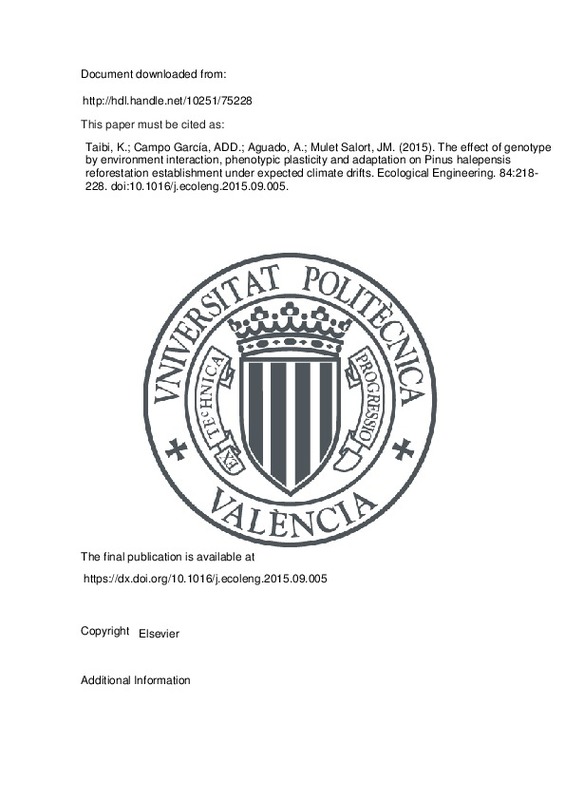JavaScript is disabled for your browser. Some features of this site may not work without it.
Buscar en RiuNet
Listar
Mi cuenta
Estadísticas
Ayuda RiuNet
Admin. UPV
The effect of genotype by environment interaction, phenotypic plasticity and adaptation on Pinus halepensis reforestation establishment under expected climate drifts
Mostrar el registro sencillo del ítem
Ficheros en el ítem
| dc.contributor.author | Taibi, Khaled
|
es_ES |
| dc.contributor.author | Campo García, Antonio Dámaso del
|
es_ES |
| dc.contributor.author | Aguado, Ana
|
es_ES |
| dc.contributor.author | Mulet Salort, José Miguel
|
es_ES |
| dc.date.accessioned | 2016-12-15T07:52:12Z | |
| dc.date.available | 2016-12-15T07:52:12Z | |
| dc.date.issued | 2015-11 | |
| dc.identifier.issn | 0925-8574 | |
| dc.identifier.uri | http://hdl.handle.net/10251/75228 | |
| dc.description.abstract | [EN] Genotype by environment interaction (GEI) is becoming an important issue within the proactive adaptive silviculture oriented to global changes. However, there is a considerable lack of information on how GEI and phenotypic plasticity may affect early establishment (survival and early growth) performance in many non-commercial forest species, such as Aleppo pine, a key species in semiarid forest restoration programs. The objectives of this study were to (1) evaluate the phenotypic plasticity and adaptation in the broad context of GEI of eleven Aleppo pine seed sources regarding survival, height and diameter growth after outplanting in contrasting core and marginal habitats representing core-to-dry and cold-to-core drifts and to (2) compare the efficiency of joint regression and Additive Main effect and Multiplication Interaction (AMMI) models in elucidating the pattern of the adaptation of the eleven seed sources regarding these traits. Even though phenotypic plasticity was low, more plasticity was observed in the core drift than the dry drift. Specific adaptation to extreme environments was coupled with lower phenotypic plasticity. Among traits, plasticity was lower for survival and height than for diameter in the dry drift and the opposite for the core drift. There were also significant environment, genotype and GEI effects. AMMI models revealed higher capabilities than joint regression in determining seed sources adaptation across environments. Specifically, seed sources with higher plasticity performed better on the core habitat conditions. Southern seed sources of Bética Septentrional and La Mancha suited more to the dry environment. However, Maestrazgo Los Serranos seed source grew better under the cooler local conditions. Levante Interior seed source performed as a generalist genotype adapted to both drifts. These results make a significant contribution towards reforestation programs with practical implications for abiotic stress tolerance and assisted population migration in response to climate change. | es_ES |
| dc.description.sponsorship | This work was supported by two research projects: "Application of molecular biology techniques in forest restoration in Mediterranean environments, PAID-05-11" funded by the Universitat Politecnica de Valencia (UPV), program for supporting RandD of new multidisciplinary research lines; and the contract subscribed between the UPV and the Ministry of Environment, Rural and Marine affairs (Centro Nacional de Recursos Geneticos Forestales de Alaquas) through its public partnership TRAGSA titled: "Study of seedling quality and field performance of 12 seed sources of Pinus halepensis Mill.". | |
| dc.language | Inglés | es_ES |
| dc.publisher | Elsevier | es_ES |
| dc.relation.ispartof | Ecological Engineering | es_ES |
| dc.rights | Reconocimiento - No comercial - Sin obra derivada (by-nc-nd) | es_ES |
| dc.subject | Aleppo pine | es_ES |
| dc.subject | Seed sources | es_ES |
| dc.subject | Survival | es_ES |
| dc.subject | Phenotypic plasticity | es_ES |
| dc.subject | Adaptation | es_ES |
| dc.subject | Marginal habitats | es_ES |
| dc.subject.classification | BIOQUIMICA Y BIOLOGIA MOLECULAR | es_ES |
| dc.subject.classification | INGENIERIA HIDRAULICA | es_ES |
| dc.subject.classification | TECNOLOGIA DEL MEDIO AMBIENTE | es_ES |
| dc.title | The effect of genotype by environment interaction, phenotypic plasticity and adaptation on Pinus halepensis reforestation establishment under expected climate drifts | es_ES |
| dc.type | Artículo | es_ES |
| dc.identifier.doi | 10.1016/j.ecoleng.2015.09.005 | |
| dc.relation.projectID | info:eu-repo/grantAgreement/UPV//PAID-05-11/ | es_ES |
| dc.rights.accessRights | Abierto | es_ES |
| dc.contributor.affiliation | Universitat Politècnica de València. Departamento de Ingeniería Hidráulica y Medio Ambiente - Departament d'Enginyeria Hidràulica i Medi Ambient | es_ES |
| dc.contributor.affiliation | Universitat Politècnica de València. Departamento de Biotecnología - Departament de Biotecnologia | es_ES |
| dc.description.bibliographicCitation | Taibi, K.; Campo García, ADD.; Aguado, A.; Mulet Salort, JM. (2015). The effect of genotype by environment interaction, phenotypic plasticity and adaptation on Pinus halepensis reforestation establishment under expected climate drifts. Ecological Engineering. 84:218-228. https://doi.org/10.1016/j.ecoleng.2015.09.005 | es_ES |
| dc.description.accrualMethod | S | es_ES |
| dc.relation.publisherversion | https://dx.doi.org/10.1016/j.ecoleng.2015.09.005 | es_ES |
| dc.description.upvformatpinicio | 218 | es_ES |
| dc.description.upvformatpfin | 228 | es_ES |
| dc.type.version | info:eu-repo/semantics/publishedVersion | es_ES |
| dc.description.volume | 84 | es_ES |
| dc.relation.senia | 293445 | es_ES |
| dc.identifier.eissn | 1872-6992 | |
| dc.contributor.funder | Universitat Politècnica de València |







![[Cerrado]](/themes/UPV/images/candado.png)

